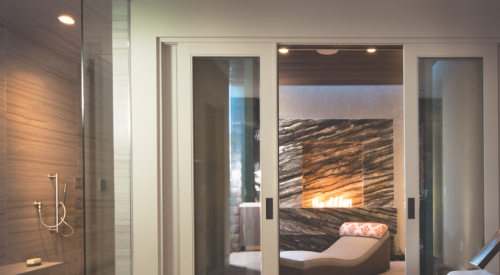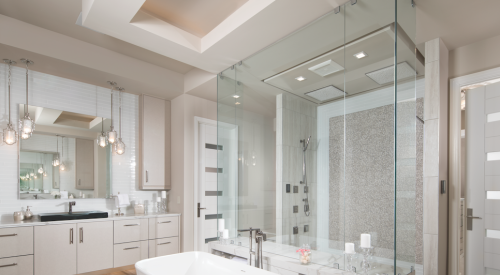|
David Hale, founder of Hale Development, Inc. in Boise, Idaho, lives in a home that is fun, yet functional – at once contemporary and earthy, yet daring and avant-garde. "My house is modern in design, but has warmth so that it doesn't feel like a concrete box," he explains.
According to Hale, the colors and finishes he chose along with the furnishings warm up the house considerably. But its unique appeal may also have something to do with how the house, in Hale's words, "captures the lay of the land." It is at one with its environment, sitting atop a hill with views of downtown Boise, which can be seen from every room (except the laundry and mechanical areas) due to Hale's clever and strategic placement of windows.
Hale, a 30-something bachelor, built his 3,100-square-foot, three-bedroom, two-and-a-half-bath home as a showpiece. He wanted to put it in the Parade of Homes, but missed the deadline. Nevertheless, he knew that he could use it to demonstrate "what I can do as a builder and what I can do inside a house that simply allows for more fun in everyday living," he says.
A lot with a viewHale moved to Boise eight years ago and stumbled upon this lot three weeks after his arrival, but didn't get control of it for nearly another six years. "It was a view lot and one of the most dynamic I had seen, so I knew it would allow me to do things that I hadn't before.
"Over the course of that time," he continues, "I started developing more modern tastes for a simpler way of living, as well as ideas on how I wanted a house to feel. I wanted to bring the outside in and feel good about the products I was putting in there."
Hale started construction of the home in November 2002 and finished six months later in May 2003. When clients drive up, they see a modern, two-story exterior that is a series of angles and slopes, not unlike the hill he built it on. Upon closer inspection, visitors discover the home has a very open, loft-like floor plan and that it possesses spectacular views of the city from not just two levels, but three.
A daylight basement with two bedrooms, a recreation room and an insulated music room ground the home. The main floor, with 10 to 11-foot ceilings, consists of a single, large area in which the kitchen flows into the living and dining rooms. The master suite occupies the top floor.
Hale's window on the worldHale strived to use windows as pieces of art in his new home; he wanted to use these openings to frame the breathtaking views of Boise and the surrounding areas.
He got his chance in the dining room, which originally called for a 10-foot, sliding glass door to open onto the deck. Hale instead opted to install a commercial-grade glass garage door that would allow the entire wall to disappear up into the ceiling, taking full advantage of the view and bringing in the outside in a way few think possible.
Having seen this type of window in restaurants, Hale had always wanted to do something similar in a home. With his floor plan, he finally had the right application. "The door opens up the whole house, so that I have phenomenal views into the city," he enthuses.
The tricky part was finding a way to run the tracks into the ceiling without interfering with the dining room's overhead lighting. The answer came by dropping the dining room ceiling down a foot to 10 feet – the same height as the kitchen, but lower than the living room. He also made sure he'd have access to the tracks through the attic, in case they ever had to be serviced.
The cool factorAside from the windows, among Hale's favorite features are his two custom-built, secret bookcase doors that access his mechanical room and music room. He started building secret doors with his first house in Boise in 1998, and it's part of Hale's penchant for building fun into his homes. Secret doors conjured up fond memories of his childhood home.
"I grew up in a house that had a lot of secret doors, so I wanted to bring them into my own home to access areas that don't need to be looked at as a door," he says. "Over time, people would ask me to put these areas inside their houses, too. It's different and there's definitely a cool factor with it."
The original plan called for a door in the entryway to access the furnace and water heater. Hale didn't want to have a plain door staring down visitors, so he drew up an alternative concept and took it to a finish carpenter. Today, visitors enter the house and see a bookcase, not a door to a utility room.
Hale took the same approach with his music room. There, he built two secret bookcase doors to access this basement-level, a 10 x 10-foot room that houses his drum set and guitars as well as stereo components. No one would even know the room existed without being told, because it is also soundproofed. He created 10-inch thick insulated walls that make use of channel locks and foam to help dampen the sound.
"Drumming is loud; my music is loud," Hale explains. "I wanted to have good sound in there when I'm playing."
The ultimate locker roomTwo floors up, the master bath incorporates the same aura of fun and has Hale's distinctive signature on it. He takes credit for the design of the master bathroom tile work, shower-and-tub design, cut-glass countertop and mirror.
Working with the radiuses of the room instead of angles, Hale designed a deep oval soaking tub that is nestled inside a shower area. These two spaces flow into the contoured countertop that is accented with a matching mirror. The custom walk-in shower is locker room-like in its openness, with no doors or partitions – in keeping with the tone of the rest of the house. "There aren't too many right angles; it's just kind of flowing," notes Hale.
Hale likes to incorporate water themes into his personal bathroom. In doing so, he makes heavy use of blue, his favorite color, which plays to the cool, refreshing environment Hale sought to create. For example, the tub-and-shower area is coated in iridescent blue mosaic tiles from Mexico. "It took some time to get the tiles, but with proper planning we finally got them here," remembers Hale.
The countertop, an aqua-colored glass, was a special-order, custom-cut from a template Hale created from cardboard. He used the same pattern for the mirror. The counter is topped with two American Standard vessel sinks with rounded faucets from American Standard's Porcher line.
A Toto toilet, featuring a heated Washlet (Chloe) bidet-type seat, rounds out the master bath and gives visitors plenty to talk about.
Cooking up a good timeIn contrast to the cool blues of the master bathroom, the kitchen is earthy, yet superbly efficient, featuring a concrete countertop on the gourmet island and dark-slab granite elsewhere. Another striking design element is corrugated metal, which Hale also used on the roof. Standing at the kitchen sink, Hale has direct sight to the television built into the wall over the living room's gas fireplace.
There's an abundance of stainless steel and ultra-modern conveniences on the main floor, all of them complementing the sleek, contemporary décor.
Would Hale do anything differently if he had the chance? Yes, he admits. He'd change the position of the refrigerator in his master bathroom by putting it under the linen cabinet rather than above. "I wanted to keep water in the fridge there, but this one sits higher than I would like. I'm tall enough to reach it, so it isn't a big deal, but a future owner who is only 51/2feet tall will likely find it difficult to access."
Upon further consideration, Hale adds, "I would install a door going out to one of the parapets from the master suite and use it as a rooftop sitting area or garden." Although he constructed a window opening so that area could be accessed in the future, he'd prefer either a regular swinging door or a garage door.
"When you walk up stairs to the master suite, there's an 8 x 12-foot sitting area there that could potentially open up to the parapet rooftop," Hale comments. "But I didn't have the means to do it at that point in the construction process, so I framed it in and installed a window instead, in case someone wants to do it later."
|








